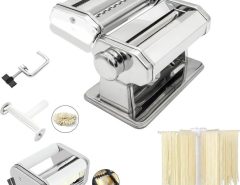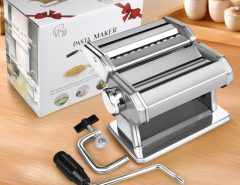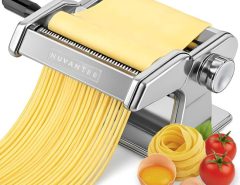Nothing beats the taste of fresh pasta made at home. However, cleaning and maintaining your pasta maker the right way is essential to keep it in top shape. A well-maintained machine ensures perfect pasta and prevents damage. Many owners overlook this, leading to rust or clogged rollers. This guide offers simple steps to care for your machine. With proper cleaning, your pasta maker will last years. Let’s dive into why it matters and how to do it right, so you can enjoy homemade pasta worry-free!
Why Cleaning Your Pasta Maker is Crucial
Cleaning and maintaining your pasta maker the right way prevents buildup of dough and flour. Leftover residue can harden, making rollers sticky and affecting pasta texture. Additionally, neglecting cleaning risks bacterial growth. According to a 2019 study by the USDA, improper cleaning of kitchen tools can lead to contamination. Regular care keeps your machine hygienic.
Moreover, a clean pasta maker lasts longer. Rust or jammed parts often result from poor maintenance. For example, I once forgot to clean my machine after use, and the rollers seized up. A quick scrub saved it, but it taught me the importance of routine care. Therefore, cleaning ensures both safety and durability.
Tools You’ll Need for Cleaning
Before starting, gather the right tools. This makes cleaning and maintaining your pasta maker the right way easier. You don’t need fancy equipment, just a few household items.
- Soft brush: Removes dry flour and dough.
- Damp cloth: Wipes surfaces without soaking.
- Wooden skewer: Clears dough from tight spots.
- Dry towel: Dries parts to prevent rust.
Avoid using soap or water unless the manual allows it. Most pasta makers, like Marcato models, recommend dry cleaning. According to a 2021 KitchenAid manual, water can damage metal parts. My first attempt at cleaning involved soap, which left streaks. Switching to a dry brush worked better. Thus, simple tools ensure effective cleaning.
Step-by-Step Cleaning Process

Cleaning your pasta maker doesn’t have to be hard. Follow these steps to do it right. First, unplug the machine if it’s electric. Then, use a soft brush to remove loose flour and dough. Focus on rollers and crevices. Next, use a wooden skewer to dislodge stuck bits. Be gentle to avoid scratches.
Afterward, wipe the exterior with a damp cloth. Don’t soak the machine, as moisture causes rust. Finally, dry thoroughly with a towel. I learned this process after struggling with sticky rollers. Regular brushing now keeps my machine spotless. Therefore, consistent cleaning keeps your pasta maker in great condition.
How to Maintain Your Pasta Maker
Maintaining your pasta maker goes beyond cleaning. Regular checks prevent long-term issues. First, inspect rollers for wear or rust monthly. Apply a drop of mineral oil to metal parts if recommended by the manual. This keeps them smooth. Additionally, store the machine in a dry place to avoid moisture damage.
Moreover, tighten loose screws to ensure stability. A 2020 study by Consumer Reports found that poor storage shortens appliance lifespans by 20%. I store my pasta maker in a cabinet with a silica gel packet to absorb humidity. This simple habit has kept it rust-free for years. Thus, proper maintenance ensures your machine stays functional. Let’s explore 5 Features to Look for When Buying a Pasta Maker.
Common Mistakes to Avoid
Many people make mistakes when cleaning and maintaining their pasta maker. Avoiding these ensures longevity. First, never submerge the machine in water. Most pasta makers aren’t dishwasher-safe. Water can ruin bearings and cause rust. Instead, use dry cleaning methods.
Additionally, don’t use abrasive tools like steel wool. They scratch surfaces, affecting pasta quality. I once used a sponge too harshly, leaving marks on my rollers. Switching to a soft cloth fixed the issue. Furthermore, avoid leaving dough to harden. Clean immediately after use. Therefore, dodging these errors keeps your pasta maker in top shape.
When to Replace Parts or Upgrade
Sometimes, maintenance isn’t enough. Knowing when to replace parts is key. Check rollers for dents or rust. If they don’t spin smoothly, consider replacements. Many brands, like Philips, offer spare parts online. Additionally, if your machine struggles with thicker dough, it might be time for an upgrade.
Upgrading can also improve efficiency. Modern pasta makers have better motors and attachments. For instance, I upgraded to a motorized model after years with a manual one. The difference was night and day. However, only upgrade if your needs change. Thus, timely replacements or upgrades keep your pasta-making experience seamless.
Storing Your Pasta Maker Properly
Proper storage is vital for maintaining your pasta maker. Always store it in a dry, cool place. Humidity can cause rust, especially on metal parts. Use a dust cover or original box to protect it. Additionally, avoid stacking heavy items on top, as this can bend components.
Furthermore, disassemble removable parts before storing. This prevents strain on rollers. I keep my machine in a kitchen drawer with a moisture-absorbing packet. This has worked well for years. According to a 2022 Good Housekeeping guide, proper storage extends appliance life by up to 30%. Therefore, smart storage habits ensure long-term use.
Conclusion
Cleaning and maintaining your pasta maker the right way is simple yet crucial. Regular care prevents damage, ensures hygiene, and extends its lifespan. By using the right tools and avoiding common mistakes, you can enjoy perfect pasta for years. My own experience taught me the value of consistent maintenance. Don’t let neglect ruin your machine. Follow these tips, and your pasta maker will stay in top condition. Share your cleaning tips in the comments or spread this guide with fellow pasta lovers!
FAQs
How often should I clean my pasta maker?
Clean it after every use. This prevents dough buildup and keeps rollers smooth. A quick brush takes only minutes.
Can I use soap to clean my pasta maker?
No, unless the manual allows it. Soap can damage metal parts. Use a dry brush or damp cloth instead.
What oil should I use for maintenance?
Use food-grade mineral oil if recommended. Apply sparingly to rollers to prevent rust and ensure smooth operation.
How do I remove stuck dough from rollers?
Use a wooden skewer or soft brush. Gently scrape off dried dough. Avoid metal tools to prevent scratches.
Is it safe to store my pasta maker in a damp basement?
No, moisture causes rust. Store in a dry, cool place with a dust cover or moisture-absorbing packet.





Leave a Reply